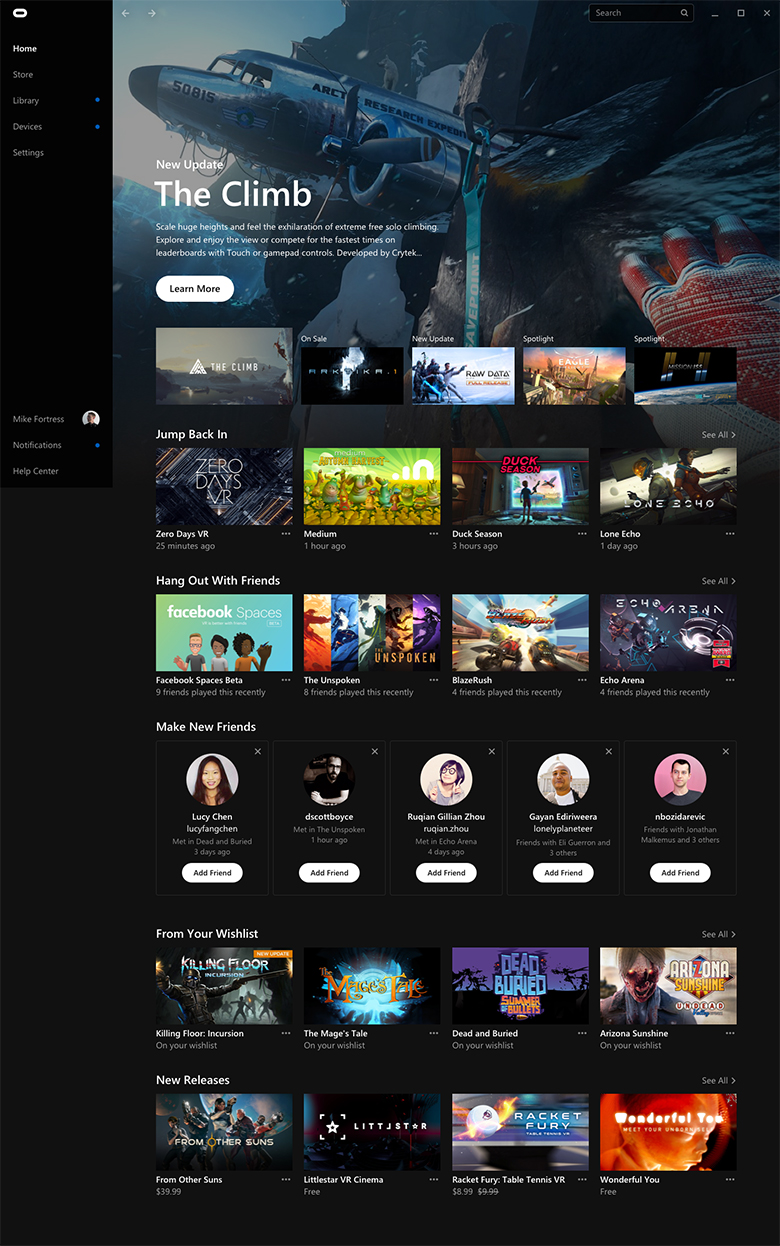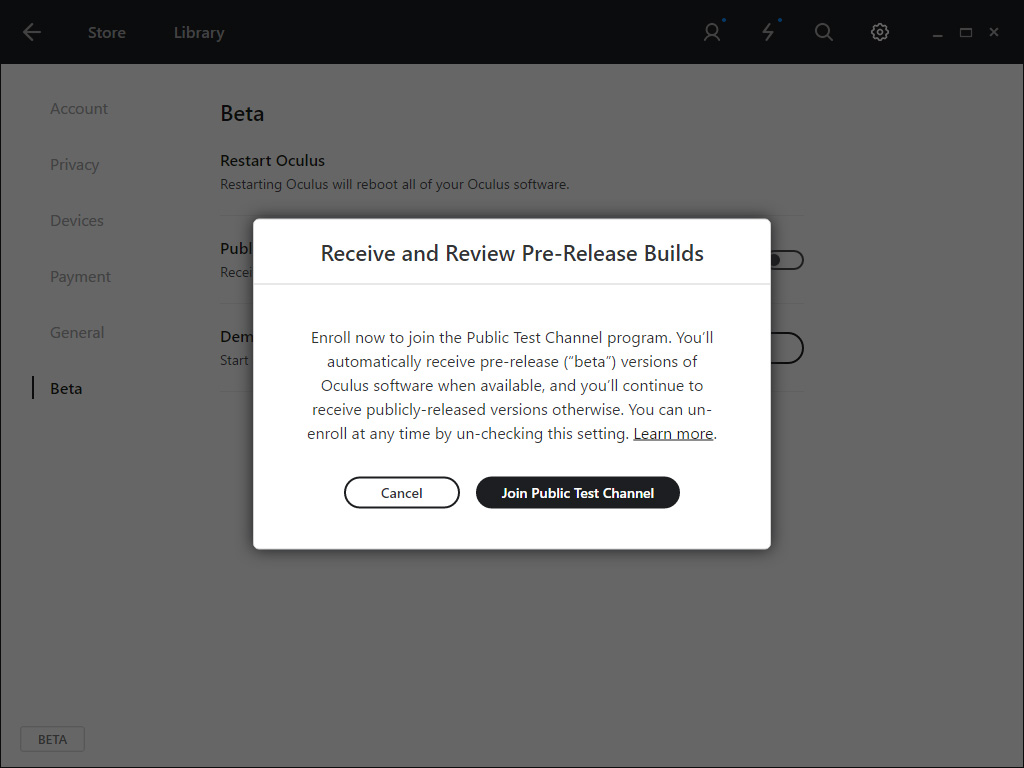Some Oculus Rift Core 2.0 Features Require Windows 10
Oculus is preparing to launch the public beta of the Rift Core 2.0 update, which includes a new store layout, a new home environment, and multi-tasking features. The update will be available to everyone with a Rift, but Windows 10 users will get a better experience.
Oculus first teased the Oculus Rift Core 2.0 update at Oculus Connect 4 in October. Rift Core 2.0 is a complete overhaul of the existing Oculus Rift platform software, including the runtime software that operates the headset, and the virtual home environment that you spend your time in between experiences. Oculus also introduced Dash, an overlay menu that you can access at any time while wearing your rift, and Oculus Desktop, which lets you access 2D desktop applications in the virtual environment. Think of it as Virtual Desktop, but built right into Oculus’ VR platform.
Today, Oculus revealed that the Rift Core 2.0 Update would also include a redesigned Oculus desktop application. Oculus said that the new version of the desktop software should improve the user experience. In it, you’ll find a news feed with up-to-date information about promotions and updates, and an improved store experience with updates about the latest releases and features titles. The upcoming desktop app also includes a quick access menu to access your most recently played titles.
Oculus is also making it easier to connect with friends. The new desktop application will let you see the games that your friends own to make it easier to organize multiplayer matches. It also lets you see your friend’s friend lists, to promote meeting new people.
Touch Strongly Encouraged
When Oculus launched the Rift headset, the kits included an Xbox One controller to navigate menus and play games. These days, all Rift headsets include Oculus Touch motion controllers, and Oculus is tailoring the next home environment to motion controls. The new update supports gamepad navigation, however, some of the features, such as customizing your Home space, require Touch controllers.
Win 10 Recommended
If your PC is still running Windows 7 or Window 8, you may not see the value in updating early. Oculus said that the Oculus Desktop feature, which lets you access Windows apps in VR, is only available on Windows 10. The Oculus Dashboard menu also doesn’t work as an overlay on older operating systems. PCs with Windows 10 installed will need the latest GPU drivers to enable Oculus Dash’s overlay feature.
Oculus said the Rift Core 2.0 update would be available as a beta in December. The beta release is an optional update that you must elect to install. To access the beta, open the settings menu in the Oculus desktop software. Navigate to the beta tab, and flick the switch next to “Public Test Channel.”
Get Tom's Hardware's best news and in-depth reviews, straight to your inbox.
Oculus warns that the Rift Core 2.0 Beta is not for everyone. The company said to expect bugs in the early release. If you demand a trouble-free experience, sit back and wait until Oculus is ready to roll Rift Core 2.0 to everyone.
Kevin Carbotte is a contributing writer for Tom's Hardware who primarily covers VR and AR hardware. He has been writing for us for more than four years.
-
AgentLozen There must be some Windows 10 exclusive feature that it leverages that reduces older Windows compatibility. Yeah.... I bet the reason's REALLY good. Something incredibly technical that us normal people would never understand.Reply
... I'm sorry, what was that? It was a decision by the marketing department? Oh. -
therealduckofdeath Yeah, because Bill Gates owns Facebook, right Agentlozen? :)Reply
Since it's something with how overlays are rendered, I'm guessing it's a DX12 hardware layer feature. -
AgentLozen Replytherealduckofdeath said:Yeah, because Bill Gates owns Facebook, right Agentlozen? :)
Since it's something with how overlays are rendered, I'm guessing it's a DX12 hardware layer feature.
Hey! Thanks for the reply therealduckofdeath.
I suspect that there's a business relationship between Microsoft and Oculus VR (Facebook). The Oculus Rift originally came packaged with an XBox One controller and the Oculus Rift Core 2.0 has Windows 10 specific features. It's not unthinkable that Microsoft "encouraged" Oculus VR to develop in that direction.
The current market share of operating systems shows that both Windows 7 and 8.1 account for more than 50% of all operating systems in use. The runner up is Windows 10 at less than 30%. In my last post I was glib because I feel like developing features that require Windows 10 is underhanded considering most users won't be able to utilize them.
Windows 10's minimum system requires ask for a DX9 graphics compliant video card. The recommended requirements even suggest a WDDM 1.3 or higher device. That probably means that the Windows 10 GUI isn't rendered in Direct X 12. Instead, Direct X 9 is more likely.
At any rate, I appreciate your enthusiasm at the very least but you should keep a more open mind about these kinds of things. -
therealduckofdeath Non-tinfoil hat reason the original Rift was bundled with an Xbox controller: Their own controller wasn't completed yet and the Xbox controller is the de-facto standard device on Windows (for shockingly obvious reasons)Reply
Your selective comparison between Windows versions to "prove a point" is so dead it's sad. Please remind me when Windows 8 had a market share over 30%, because it never did. Windows is without any comparison the largest software ecosystem, dwarfing anything else. Windows is also not freeware, meaning people will generally avoid buying a new version unless there's a real need for it (transition from DOS to Windows 95 and Windows 9x to Windows XP are the two that comes to mind).
I don't know if you're really dreaming of a new complete break from current compatibility or if you're just grasping random "arguments" to feed your standard whining about Windows.
The fact is, Windows 10 has hardware level features none of the previous editions had, which means some features will only work on Windows 10. Please, keep your tinfoil hat theories to 4chan and obscure sub-reddits... :D -
bigpinkdragon286 Reply
There doesn't have to be any particular technical reason relating to Windows and it may come with no malicious intent of the developer. It could just be a redirection of development resources needed to both code for and QA test the Oculus Home software for multiple versions of Windows, which at some point happens with all products.20428329 said:There must be some Windows 10 exclusive feature that it leverages that reduces older Windows compatibility.
You could even ask if companies that made hardware devices that ran under Windows 98, where those hardware devices are still otherwise in good working order today, should produce drivers to use those same devices on Windows 10. Part of the cost of any hardware device is the software development. The cost is initially covered through device sales. At some point, the end user will either need to fund further support of software themselves (not really a practical option) or accept that the device is no longer supported in some fashion, although it more than likely retains it's original functionality. So, Oculus isn't taking away anything that it's users enjoyed on either Windows 7 or 8 platforms, just offering a better experience going forward on the Windows 10 platform.
Microsoft did have a partnership with Oculus to provide both the XBox One controller and wireless adapter that shipped in the early Rift bundles. I wouldn't however conclude from this that Oculus is obliged to reciprocate by urging users to upgrade to Windows 10. Initially, Windows 10 was a requirement for Microsoft's wireless XBox adapter, which of course has nothing to do with Oculus.20429099 said:I suspect that there's a business relationship between Microsoft and Oculus VR (Facebook). The Oculus Rift originally came packaged with an XBox One controller and the Oculus Rift Core 2.0 has Windows 10 specific features. It's not unthinkable that Microsoft "encouraged" Oculus VR to develop in that direction.
Despite Oculus having a partnership with Microsoft, in 2015 they released this statement:
Our software team is working as quickly as possible to complete Windows 10 compatibility with our SDK and the Oculus Runtime. As Windows 10 is not officially supported at this time, we strongly suggest that Oculus Rift Development Kit 2 owners do not upgrade from previous versions of Windows until we have the officially updated SDK and Oculus Runtime available.
Something else we aren't fully aware of is, the percentage of Rift users who are on each Windows version. If Oculus collects any metrics here, they probably realize already the impact this is going to have on their install base. -
epdm2be If Windows 10 just didn't look so FUGLY, Djeez! I loved Aero. The clear and distinguishable shiny buttons and window borders, the milky white transparency, the soft shadowing and the lovely detailed icons. Yes, I'm a sucker for skeuomorphism because it is clear and, from Vista on, absolutely gorgeous.Reply
I've had my share of that the flat ugly stuff in the early nineties. The monotone icons were fine for a simple phones of the past but on powerfull PC with high-end GTX-videocard and shiny 28" IPS-monitor I expect more... a LOT more.
Microsoft URGENTLY need to create a skeuomorphic theme for Windows 10 because just for its looks alone I will reject Win10 for as long as possible. I keep wondering why the f@ck they didn't they make that theme already. They KNEW the resistance against Metro (or whatever the damn thing is called now) from Windows 8. They had plenty of time to create a Windows 10 theme to persuade people to give it it a shot. WTF is wrong with them? Don't these bozo's realize that by enforcing you only create more resistance? -
therealduckofdeath Reply20431911 said:...skeuomorphism ....gorgeous...
:pt1cable: I thought I'd heard it all...
Skeuomorphism will hopefully stay dead forever. The latest 2017 fall update did bring added depth to the UI, including custom transparency effects and a few enhanced 3D effects. That's more than enough for me. The old faux glass, metal and leather just looks terrible on a high resolution clear display. -
bigpinkdragon286 Microsoft would do well to soften their control strings a tad and just allow folks to fully customize the Windows UI, making personal themes outside of the strict, limited fashion they allow for now. The problem of people disliking "the one UI to rule them all" nonsense would solve itself by allowing so many different variations on how things looked there would likely be something that looked just right to everyone, or they could create their own.Reply
Whether one likes skeuomorphic design or hates it, the choice of what one's interface looks like on their personal equipment should belong to the end user, not some engineer in Redmond.
Provided the UI system was forward thinking enough, a variable UI wouldn't be a support issue. Just include a keyboard shortcut or Power User Menu item to switch between the default UI and user selected one.


